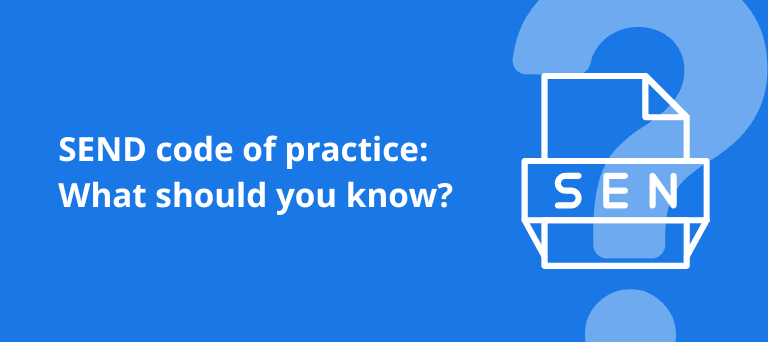Zen Educate Content Team
19 May 2024
5
min read

As educators, supporting students with special educational needs and disabilities (SEND) is a critical responsibility. At the heart of this endeavour lies the SEND Code of Practice, a comprehensive guidance document that outlines the legal framework, principles, and best practices for identifying, assessing, and meeting the diverse needs of learners. Whether you're a seasoned teacher or a dedicated teaching assistant, mastering the SEND Code of Practice can unlock new opportunities for professional growth and enhanced student outcomes.
What is the SEND Code of Practice?
The SEND Code of Practice is a statutory guidance document established under the Children and Families Act 2014. It serves as a cornerstone for inclusive education, providing clear directives for supporting children and young people aged 0 to 25 with special educational needs or disabilities. This comprehensive guide outlines the responsibilities of various stakeholders, including schools, local authorities, and health and social care services, in ensuring that every student receives the tailored support they need to thrive.
The SEND Code of Practice has undergone several revisions over the years, with the most recent iteration published in 2015. This updated guidance reflects the evolving landscape of SEND provision, incorporating key changes and advancements in the field. By familiarising themselves with the current version of the Code, educators can stay informed about the latest policies, practices, and resources available to support their students.
Key Principles of the SEND Code of Practice
At the heart of the SEND Code of Practice are three core principles that underpin its approach to inclusive education:
Inclusivity
The Code emphasises the importance of creating inclusive learning environments where barriers to participation and learning are identified and removed. It encourages educators to adopt a whole-school approach, fostering a culture of acceptance and understanding towards students with diverse needs.
Collaboration
The SEND Code of Practice underscores the significance of collaborative working among parents, educators, and external agencies. By facilitating open communication and joint decision-making, the code aims to ensure that students receive a cohesive and holistic support system.
Individual Needs
Recognising that each student is unique, the Code promotes the provision of tailored support and interventions to address the individual educational needs of children and young people with SEND. This personalised approach is crucial for maximising student progress and well-being.
Legal Framework
The SEND Code of Practice is a statutory document, which means that schools, local authorities, and other relevant organisations are legally required to have regard to its guidance. This legal framework outlines the responsibilities and obligations of these stakeholders in supporting students with SEND.
Statutory Requirements
Under the SEND Code of Practice, schools are required to:
Identify and assess the special educational needs of their students
Provide appropriate support and interventions to meet these needs
Collaborate with parents and external agencies to ensure the best possible outcomes
Publish a SEN Information Report detailing their approach to SEND provision
Local authorities, on the other hand, have a duty to:
Maintain and publish a Local Offer, which outlines the educational, health, and social care provision available in the area
Conduct Education, Health and Care (EHC) needs assessments and issue EHC plans where necessary
Ensure that the special educational provision specified in EHC plans is made available
Compliance and Consequences
Adherence to the SEND Code of Practice is crucial, as non-compliance can have serious consequences. Schools and local authorities that fail to meet their statutory obligations may face legal challenges, financial penalties, or even intervention from the Department for Education. Conversely, by fully embracing the Code's guidance, educators can demonstrate their commitment to inclusive practice and ensure that their students with SEND receive the support they are entitled to.
Implementation of the SEND Code of Practice
The successful implementation of the SEND Code of Practice requires the active involvement and collaboration of various stakeholders, each with their own roles and responsibilities.
Roles and Responsibilities
Schools: Identify and assess students' needs, provide appropriate support, and work closely with parents and external agencies.
Teachers and Teaching Assistants: Deliver high-quality teaching and personalised interventions to meet the needs of students with SEND.
Special Educational Needs Coordinators (SENCOs): Coordinate the school's SEND provision, advise colleagues, and liaise with external professionals.
Local Authorities: Maintain the Local Offer, conduct EHC needs assessments, and issue EHC plans where necessary.
Parents and Carers: Actively participate in decision-making processes and work in partnership with schools and local authorities.
Educational Settings
The SEND Code of Practice applies to a wide range of educational settings, from mainstream schools to special schools and alternative provision. Regardless of the setting, the principles of inclusivity, collaboration, and individualised support remain paramount. Educators in all contexts must familiarise themselves with the Code's guidance and ensure that their practices align with its requirements.
Impact of the SEND Code of Practice
The SEND Code of Practice has had a significant impact on the education of children and young people with special educational needs and disabilities. While the implementation of the Code has led to some notable successes, it has also faced various challenges and critiques.
Success Stories
The Code has facilitated greater inclusion and participation of students with SEND in mainstream educational settings. By promoting collaborative working and individualised support, the Code has enabled many learners to thrive and reach their full potential. Numerous case studies have highlighted the transformative impact of the SEND Code of Practice on student outcomes, both academically and in their personal development.
Challenges and Critiques
Despite its positive intentions, the SEND Code of Practice has not been without its challenges. Some have criticised the complexity of the guidance, arguing that it can be difficult for schools and local authorities to navigate. Additionally, concerns have been raised about the availability of resources and funding to effectively implement the Code's requirements, particularly in the face of budgetary constraints.
Resources and Support
To support educators in understanding and implementing the SEND Code of Practice, a range of resources and training opportunities are available.
Support for Stakeholders
Schools, teachers, and local authorities can access guidance and support from various sources, including:
The Department for Education's SEND Code of Practice guidance
SEND-specific training and professional development programmes
Collaboration with SEND specialists and external agencies
Online resources and forums for sharing best practices
Further Reading and Training
For those seeking to deepen their understanding of the SEND Code of Practice, there are numerous books, articles, and training courses available, such as:
The SEND Code of Practice: 0 to 25 Years from the Department for Education
Inclusion in the Early Years by Kathy Brodie
SEND-focused training courses offered by organisations like the National Association for Special Educational Needs (NASEN)
By engaging with these resources and opportunities, educators can enhance their knowledge, skills, and confidence in supporting students with SEND, ultimately contributing to more inclusive and effective educational practices.
Conclusion
The SEND Code of Practice is a pivotal document that has transformed the landscape of inclusive education in the United Kingdom. By outlining the legal framework, principles, and best practices for supporting children and young people with special educational needs and disabilities, the Code has empowered educators to create more inclusive learning environments and ensure that every student receives the tailored support they deserve.
As you navigate the complexities of the SEND Code of Practice, remember that you are not alone. A wealth of resources, guidance, and support is available to help you on your journey. By embracing the Code's principles and continuously striving to improve your practice, you can make a meaningful difference in the lives of your students with SEND, preparing them for a future filled with opportunities and success.
Want support with SEN in education career? Sign up to Zen Educate and get specialised support, resources and advice with SEN – as well as access to higher-paid jobs.



